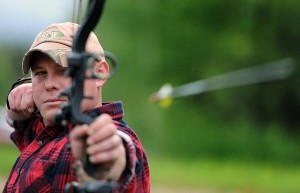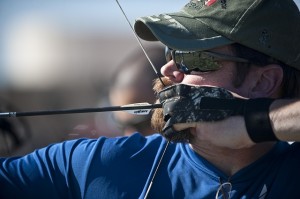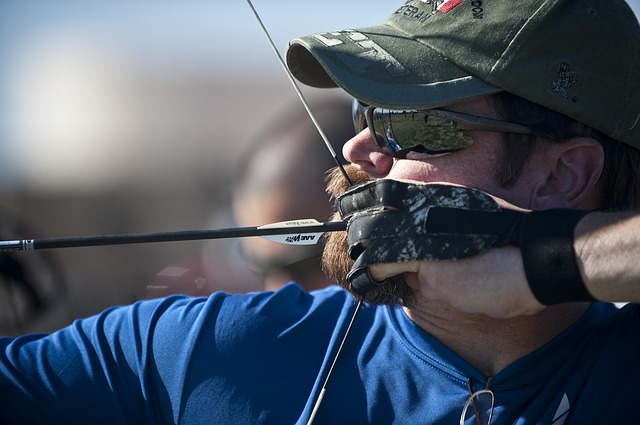Are you thinking about getting into archery? Our resident archery enthusiast James gives us his advice on how to fire a recurve bow.

In my experience, there are various different ways in which you can shoot a bow depending on your style of archery. For instance, an archer using bare bow style, a recurve without the use of sights, counterweights etc, may “snap shoot” where you use very little time to actually aim at the desired target but instead instinctively “feel” the shot.
A target archer using sights however, will take more time and think about where the arrow is going, ensuring all the possibilities that could make the shot go wrong are limited by using the same methods every time, such as draw length, stability, a smooth release etc..
Here I am going to cover some of the basic techniques that are required when shooting with a recurve bow. These are basic tips to help you achieve a consistent level of archery so if you use sights or shoot bare bow style, this advice should hopefully help you get you on your way to successful shooting.
Your Archery Stance
One of the first things to consider after you’ve got your archery supplies, when shooting any bow, is the way in which you stand when doing so. You should be standing sideways on towards the target, with your feet shoulder width apart. This will give you stability when shooting and ensure you are able to get the most power out of your shot, for you will now be drawing the bowstring straight across your body to your draw point.
Holding the Bow
It is important that you hold the bow correctly because this can have a huge impact on the shot you are taking. Personally, I don’t use an armguard when shooting, and I would recommend this to any beginner. This is because as long as you have you arm in the correct position when shooting; the bow string won’t hit your arm.
If your hold is incorrect, you arm will feel the recoil of the string, and this can become quite painful over time, as your arms becomes more sore. In this way, bad technique is punished, and you are encouraged to get it right. Instead, the right way is to not to have your arm dead straight, but in fact with a slight bend at the elbow and locking this position in place.
Gripping the Riser
Another thing to consider is how hard you need to grip the bow. If you are clutching the riser for dear life then this can dramatically throw the arrow off to either side of the target. This is to do with how the energy from the bow is displaced and when held too tightly the energy from releasing the string will all be put into the back of the arrow making it “fish tail” thus loosing accuracy.
This is why many target archers will use finger or wrist slings, so the bow may be gripped ever so lightly and allowed to dip forward after every shot without dropping the bow.

The Draw
As a budding archer, you must decide for yourself the most comfortable way to draw the string back, and there are various schools of thought on this. Many who teach archery to people will say to put three fingers under the arrow because this is the easiest way of doing so (Three fingers being your index, middle and ring finger).
A better and more widely used method by both target archers and hunters is to “split” your fingers by having one above and two below. This is where the index finger is above where the arrow is on the string with the middle and ring finger below. Also, your fingers will need to be gripping the string at your first knuckle to ensure you aren’t holding too loose or too firmly.
Bare Bow vs Target Archery Drawing
When it comes to drawing, the differences in target and bare bow recurve shooting become starkly apparent. As a barebow shooter, with the bow lightly held in place, you will draw to the side of your face so as to almost touch your cheek with your fingertips, looking down the arrow towards the archery target you wish to hit.
A target archer however will use a different technique where you will draw the bow under your chin so your fingers use your chin as an “anchor-point” and the bowstring touches your nose. This is so that the archer may use the sight to aim at the target before shooting.
Another thing to consider when drawing is to keep your elbow on the arm which is drawing the string held nice and high, as this will make it easier when releasing the shot to keep power.
Releasing The Bow String
Whatever style of shooting, a good release is essential to ensuring a powerful and accurate shot. If on releasing the string you simply let go of the string and let your hand follow the shot, a lot of power will be lost each time. The likely result will be either that the arrow hits low on the target and without much consistency, or that you miss the target altogether.
Instead, ideally, you want a powerful release. So when you are lined up and ready to shoot the arrow when letting go of the string, you should “flick” your fingers off. This is done by releasing the string whilst at the same time moving your hand backwards away from the bow. Imagine you were plucking a guitar string or pinging an elastic band. This will ensure all the energy from the bow is put into shooting the arrow powerfully and accurately.
Keep Holding On
Upon release it is also important that you continue to hold your bow up until the arrow actually hits the target. If you were to just let your arm drop as soon as you release the string you will find that most of your shots when doing so will shoot low on the target or even miss under the archery target. So it is very important to let the shot follow through until it reaches its destination.
Finally
I can’t tell you what exact technique is going to work for you, because we all differ. It is impossible to generalise, and there are too many variables in archery. I wish it could be worked out, as this would have helped me a great deal when I was learning! Instead, what I have given you here are guidelines to which, if implemented, will help you to progress. In order to make the most of these, you will need to practice, apply yourself, and try different methods. With some effort, you should find what works for you, and gives the best results when shooting.
To check out our full range of recurve bows and accessories, head to our archery supplies store.

